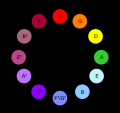Audiovisual art
This article includes a list of general references, but it lacks sufficient corresponding inline citations. (July 2013) |
Audiovisual art is the exploration of kinetic abstract art and music or sound set in relation to each other. It includes
performances and installations. [citation needed
]
Overview
The book Art and the Senses cites the
Italian Futurist artists, Fortunato Depero and Luigi Russolo as designing art machines in 1915 to create a multisensory experience of sound, movement and colour.[1] In the 1970s Harry Bertoia created sound sculptures of objects to have a multisensory effect, exploring the relationships between the sound, the initiating event and the material properties of the objects.[1] In an example with overt musical connections, The Oxford Handbook of New Audiovisual Aesthetics cites musician Brian Williams (aka Lustmord) as someone whose practise crosses audiovisual art and mainstream media, where his work is "not traditionally 'musical'" and has "clearly visual aspects".[2]
See also
- Abstract film
- Audiovisualogy
- Color organ
- Experimental film
- Sound art
- Sound installation
- Sound sculpture
- Synaesthesia
- Video art
- Visual music
- Audiovisual performance
- New media art
References
- ^ ISBN 978-0-19-923060-0
- ISBN 978-0-19-973386-6
Further reading
- ISBN 9780070700154.
- Adriano Abbado, "Perceptual Correspondences of Abstract Animation and Synthetic Sound", Leonardo, Volume 21, Issue 5, MIT Press, 1988 [1]
- Andy Hunt, Ross Kirk, Richard Orton, Benji Merrison, "A generic model for compositional approaches to audiovisual media", Cambridge Journals, 1998 [2]
- Rodrigo F. Cádiz, "Fuzzy logic in the arts: applications in audiovisual composition and sound synthesis", NAFIPS, 2005 [3]
- Michael Faulkner/D-FUSE, "vj audio-visual art + vj culture", Laurence King Publishing Ltd, 2006
- Mick Grierson, "Audiovisual composition", into the pill, 2007 [4]
- Holly Rogers, Sounding the Gallery: Video and the Rise of Art Music (New York: Oxford University Press, 2013).

